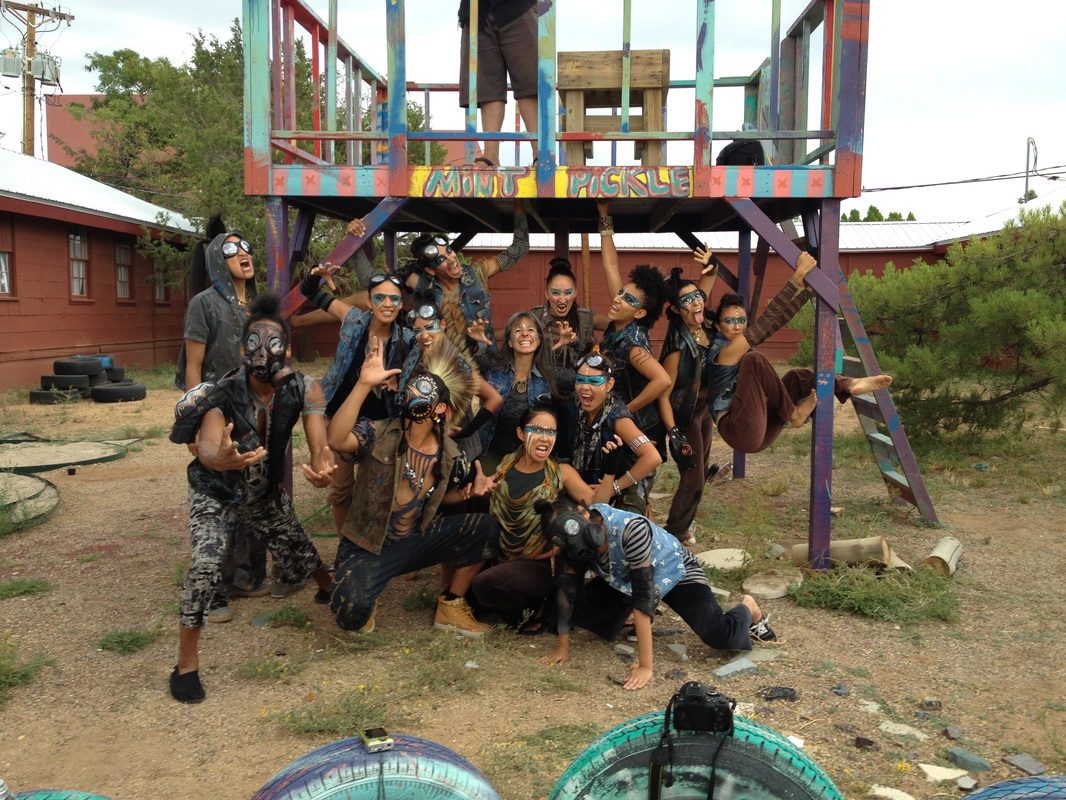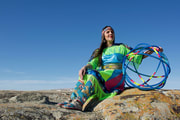|
From September 6- 30, 2012 I was honored to be part of the creation process and world premiere of Dancing Earth: Indigenous Contemporary Dance Creations, Walking at the Edge of Water with founder, artistic director and choreographer Rulan Tangen and choreographic dramaturge, Jack Gray (Maori) at the Lensic Theater in Santa Fe, NM. Rulan describes this work in the following excerpt:
17 originating cast members, from USA, Canada, New Zealand, representing 21 First Nations of Maori, Inuit, Purhepecha, Laguna and Santo Domingo Pueblo, Dine, Apache, Cree, Ojibway, Anishnaabeg, Samoan, Hopi, Assiniboine, Kainai, Metis, Papanga, Shoshone, Fulani, Meherrin, Zapotec, Tsalagi and Taino. DANCING EARTH celebrated IAIA's 50th anniversary with a world premiere co-presented by Lensic, Santa Fe Art Institute and IAIA - in a multi-disciplinary expression of arts dedicated to the healing of water. Expressionistic movement, traditional songs, spirals of smoke from sage and sweetgrass, visions of paintings, films and photos projected into different dimensions turning a theatrical box into a transparent spherical world, spoken word poetry, live vocals, costumes made from salvaged fabrics and window screens with painted pottery designs, petroglyphs, graffiti, oil spills and clay ... I participated in two previous intensives as part of the initial research, creation and development of this major work focused on the healing of water. Both times were hosted by Indigenous Performance Initiatives (IPI) collective at Trent University in Peterborough, Ontario. In March 2011 we collaboratively created and performed Walking on the Edge, of Water choreographed by Rulan. I participated as Assistant Choreographer to Daystar/ Rosalie Jones alongside students enrolled in the Indigenous Dance Theater course at Trent University in Nozhem: First Peoples Performance Space. In June 2012 I participated in another stage of development with other professional Indigenous artists, dancers and choreographers. The first half of this development was a site specific work Gaabinjigabaa’ang: Where We Come Ashore performed at the Ode’min Giizis Festival Opening in the Ayaandagon garden at the Art Gallery of Peterborough, June 20, 2012. The second half of development included collaborators Jerry Longboat, Norma Araiza, Heryka Miranda, Javier Stell-Fresquez and Waawaate Forbister as well as guest artists Leanne Simpson, The Unity Singers and Vanessa Dion Fletcher as well as community and youth artists. The show was presented as Zhishodewe... at the Water’s Edge on June 28, 2012 at Nozhem: First Peoples Performance. For Indigenous dancers the meaning behind the dances are often the most important aspect of the performance. So in this blog post I will discuss some of the thought processes, intentions and stories that informed my movement and served as motivation throughout the piece to show how Indigenous dance can be much deeper than just aesthetics and technique. This is one of the things I have always admired about Rulan Tangen and her company Dancing Earth uses Indigenous methodologies in the creation process not only using the stories and teachings but embodying this in every stage of the work. As a Nehiyaw Iskwew (Cree woman) dancer, and for most Indigenous dancers, the emotional intent serves as the driving force behind the dance. For choreographers Rulan and Jack one of their main concerns was for the dancers to go beyond acting and pretending towards being... living the choreography as an authentic part of our reality. Rulan explained that many of the artists really were being themselves, “Sina was embodying her ancestral and spiritual practice for which she was named, as voice of water... [and] the scenes of stark emotional trauma were actually real experiences that the performers have lived.” The result was a choreographic healing ritual created collectively with the dancers and choreographers from diverse backgrounds to invoke healing of the waters of earth and of our bodies. The Prologue: Vision is a post apocalyptic scene showing the lack of water and misuse of water today. This was a group piece where each person used a personal story related to water to inform their movement, this story came out of a movement exploration of water in the studio. My theme was ‘the way it used to be’ this came from my exploration where I was drawn to Lesser Slave Lake and the way it used to look when I was a child and how it has changed since. The lake is a designated provincial park area and is the largest recreational lake in Alberta. On a regular basis it is used for sand castle competitions and fishing derbies and as a result the lake has been subjected to a lot of human impact over the years. The waters are also affected by development such as the Alberta tar sands and pulp mills. These combined effects are evident in the water and shore of Lesser Slave Lake. Nostalgic and yearning for balance and healing of the lake I imagined the lake as it once was, full of life and natural. Simultaneously mournful and hopeful my embodiment attempted to evoke crashing waves on the lake shore. Act 1, Scene 5: Reflections, also called In You I See Myself from the song title, was based on movement exploration focused on reflecting our partner through movement. We initially began with an exercise where we took our partners weight and then led them around the room with eyes closed and transformed these movements into a choreographed duet. This process led to me and my partner, Deollo Johnson to create a duet based on the law of attraction, the theory that opposites attract. We used the image of a molecule, H2O, and the positive charge of hydrogen and negative charge of oxygen to inform our movement. Deollo began his journey with heaviness in his movement (negatively charged oxygen) and I began with a feeling of lightness (positively charged hydrogen). I entered as if lost and searching and met Deollo center stage. He was slumped over in his heaviness and we began taking on each other’s qualities and reflecting each other’s movement. I was then guided around stage eyes closed and when I opened my eyes again was able to ‘see my path’. My understanding of the duet was that it created a sense of balance, through positive and negative/ male and female, and how seeking balance with others influences our own identity as the song says ‘In you I see myself’. As we began to reflect each other we also became more assured in our own identity. Through relationships with others we are able to understand our purpose in life, without others and without relationships we are lost. In terms of water there is a need for us to understand our role in the healing of water and how we also rely on clean water for our own healing... My mother has always told me that rain cleanses the spirit. Act 2, Scene 9: Statistics, Rulan shared that this scene was intended to make all the statistics about First Nations people, Indigenous people, water and the environment more relatable. Most people do not care about statistics and this scene was intended to show the audience their role in creating statistics and how these statistics influence their everyday lives. I did push ups backstage in order to get pumped up for the intensity of the scene (something I never thought I would do!). It was often referred to as the most important scene of the piece... This was what it was all about, to get people to care about the healing of water. The main thought in my head throughout this piece was, “What are we doing?” and my intention was to show everything that was ‘messed’ up with the world... consumerism, racism, sexism... I thought of the history of our people, the history of colonization and the present manifestations and continuation of this history... For myself the scene was very intense in the anger, greed, hatred, illness and pain that I had to represent, which are all effects of our compliance in society, not caring about all the statistics and not caring about our environment. Act 2, Scene 12: Mourning was performed by a trio of women including Dancing Earth company members Erika Archer and Nichole Salazaar and myself as a cast member. Described by Rulan as “feminine prototypes, embodying the idea that as protectors of water, women also are feeling the sorrow of what has happened to water and indeed to their own status as women - the oppression, forgetting of respect and sacredness, the wastefulness.” The choreography was based on several Native traditions for mourning, including washing the hair and cutting the hair. We also used hand painted bowls as props, which were inspired by Native clay pottery customs. Getting into the scene was made easier because it followed Statistics and Ancestors Lament a powerful and moving duet with Rulan and Jack where ‘Ancient ancestors are awakened into this nightmare – energy of death, disturbing the ancient fossils and grinding them up’ (Rulan Tangen, Narrative for Walking at the Edge of Water). Before I even stepped on stage I began to think ‘What have we done?’... what have we done to the earth, to water, air, trees and to each other? Then before even stepping on stage I would pray for forgiveness for myself and for all of us... praying for pity from the creator. I truly felt that this helped me to experience the mourning dance as a powerful and important piece in the healing of water. I hope that real tears on stage also helped the audience to also understand and feel what this scene was about. In the Anishnaabe (Ojibway) culture water is related to the emotional and tears are part of healing. The scenes Mourning, Ancestors Lament and Sacrifice were the trans-formative pieces and helped lead the way towards healing, purification and ritual. The piece ended with passion. We ‘splashed onto the stage’, as described by Jacqueline Shea Murphy, in Act 2, Scene 15: Offerings which represented the restoration of healing and balance of water. We are the offerings to water... we offer ourselves; we offer our love and gratefulness in order to change our thoughts and behaviors to keep water sacred and to keep the water alive for future generations... “We are the ones we have been waiting for” – Hopi saying shared by Rulan Tangen Ninanaksomun, I am thankful. Dancing Earth: Indigenous Contemporary Dance Creations: http://www.dancingearth.org/ Promo video for Walking at the Edge of Water: http://www.youtube.com/watch?v=U4p3e9LsBTY&feature=youtu.be This apprenticeship sponsored by Canada Council for the Arts.
0 Comments
Leave a Reply. |
Nehiawsko Pikiskwew'Cree Woman Speaking' is a space to share my voice. My goal is to spread awareness and share wisdom as I learn and grow as a dancer, choreographer, and woman. My passion is to show the healing power of dance and culture. I love learning from elders, experience, and research and being able to synthesize Native and non-Native ways of knowing! Archives
November 2023
Categories
All
|

